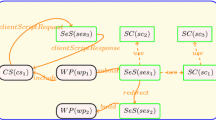Abstract
With the requirement for complex Web Services steadily increasing, there is a growing interest for reusing basic, existing Web Services to composite new ones. We present a composite Web Services development approach driven by model driven architecture (MDA): using UML (Unified Modeling Language) class diagram to model structure PIM (Plateform Independent Platform) and UML activity diagram to model behavior PIM, then by model transformation converting the PIMs to specific Web Services specification plat-forms and execution platform to get the corresponding PSMs (platform specific models). The main contributions of this paper are the all-around solution to Web Services composition development and the transformation rules for structure and behavior model of Web Services between PIMs and PSMs.
Similar content being viewed by others
References
Hamadi R, Benatallah B. A Petri Net-Based Model for Web Service Composition.Australasian Database Conference (ADC). Adelaide, Australia, February 2003. 191–200.
Narayanan S, McIlraith S A. Simulation, Verification and Automated Composition of Web Services.Eleventh International World Wide Web Conference (WWW-11), Hawaii, June 2002. 77–88.
Rao J H, Kuungas P, Matskin M. Application of Linear Logic to Web Services Composition.Proceedings of the First International Conference on Web Services (ICWS' 2003), Las Vegas: IEEE Computer Society, June 2003. 3–9.
Benatallah B, Dumas M, Sheng Q Z,et al. Declarative Composition and Peer-to-Peer Provisioning of Dynamic Web ServicesProceedings of the 18th International Conference on Data Engineering (ICDE'02). Washington, DC: IEEE Computer Society, February 2002. 297.
Berardi D, Calvanese D, Giuseppe G D,et al. Automatic Composition of e-Services.Proceedings of the First International Conference on Service-Oriented Computing (ICSOC), Trento, December 2003. 43–58.
Bezivin J, Hammoudi S, Lopes D,et al. An Experiment in Mapping Web Services to Implementation Platforms, Atlas Group, University of Nantes, Research Report, March 2004.
Frankel D, Parodi J.White Paper: Using Model Driven Architecture to Develop Web Services (2nd Ed). MA: the John Wiley & Sons OMG Series, 2002.
Bordbar B, Staikopoulos A.Automated Generation of Metamodels for Web Services Language. Birmingham: University of Birmingham, 2004.
Frankel D S.Model Driven Architecture: Applying MDA to Enterprise Computing. MA: OMG Press, 2003.
Kleppe A, Warmer J, Bast W. MDA Explained:The Model Driven Architecture: Practice and Promise. Washington DC: Addison-Wesley, 2003.
Gr nmo R, Skogan D, Solheim I,et al. Model-driven Web Services Development.The 2004 IEEE International Conference on e-Technology, e-Commerce and e-Service (EEE-04), Taipei, China, March 2004, 42–45.
Dumas M, Hofstede A H M. UML Activity Diagrams as a Workflow Specification Language.Proceedings of the International Conference on the Unified Modeling Language (UML). Toronto: Springer-Verlag, 2001. 76–90.
Christensen E, Curbera F, Meredith G. Sanjiva Weerawarana, Web Services Description Language (WSDL),http://www.w3.org/TR/wsdl, March 2001.
Andrews T, Curbera F, Dholakia H,et al. Business Process Execution Language for Web Services (BPEL4WS) version,ftp://www6.software.ibm.com/software/developer/library/ws-bpel.pdf, May 2003.
Thöne S, Depke R, Engels G. Process-Oriented, Flexible Composition of Web Services with UML.International Workshop on Conceptual Modeling Approaches for e-Business: A Web Services Perspective (eCOMO 2002), Tampere, October 2002. 390–401.
Gardner T. UML Modelling of Automated Business Processes with a Mapping to BPEL4WS.The Seventeenth European Conference on Object-Oriented Programming (ECOOP), Darmstadt, July 2003.
Solheim G R. Towards Modeling Web Services Composition in UML.The 2nd International Workshop on Web Services: Modeling, Architecture and Infrastructure (WSMAI-2004), Porto, April 2004. 72–86.
Czarnecki K, Helsen S. Classification of Model Transformation Approaches.OOPSLA'03 Workshop on Generative Techniques in the Context of Model-Driven Architecture, California, October 2003, 33–50.
Object Management Group. MOF 2. 0 Query/ Views/ Transformations RFP.http://www.omg.org/cgibin/apps/do_doc?, April 2002.
Rumbaugh J, Jacobson I, Booch G.The Unified Modeling Language Reference Manual. Boston: Addison Wesley Professional, 1999.
Yang Y P, Tan Q P, Behavior Mapping Between UML Activity Diagram and BPEL.Technical Paper of National University of Defense Technology, http://www.nudt.edu.cn/computercollege/602/Tan-56.pdf, March 2005.
Author information
Authors and Affiliations
Corresponding author
Additional information
Foundation item: Supported by the National 863 High Technology Development of China (2003AA001023).
Biography: YANG Yan-ping (1980-), female, Ph. D. candidate, research direction: workflow, Web service and MDA.
Rights and permissions
About this article
Cite this article
Yan-ping, Y., Qing-ping, T., Jin-shan, Y. et al. A new approach to development of composite Web Services. Wuhan Univ. J. Nat. Sci. 11, 211–216 (2006). https://doi.org/10.1007/BF02831733
Received:
Issue Date:
DOI: https://doi.org/10.1007/BF02831733




